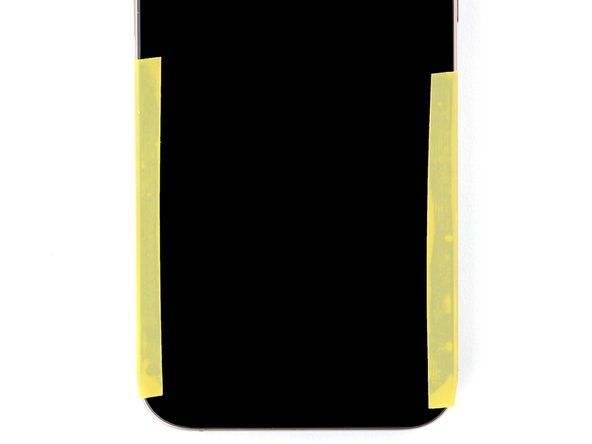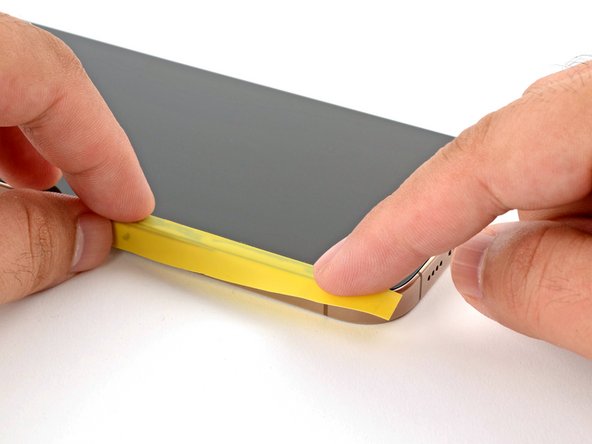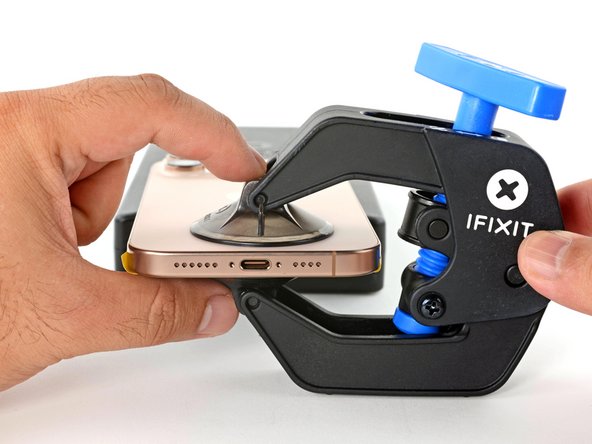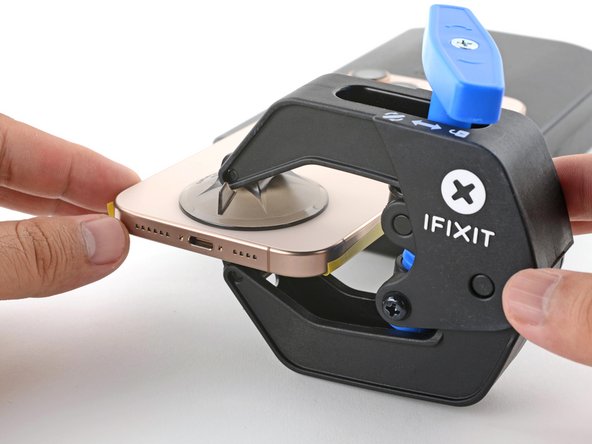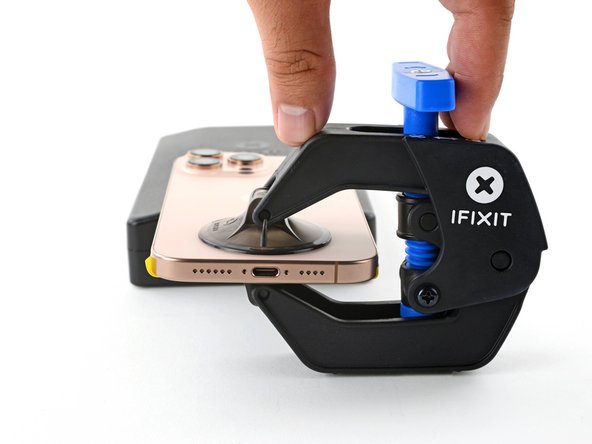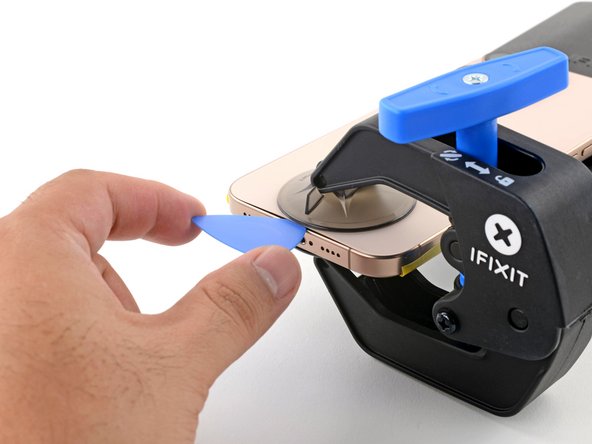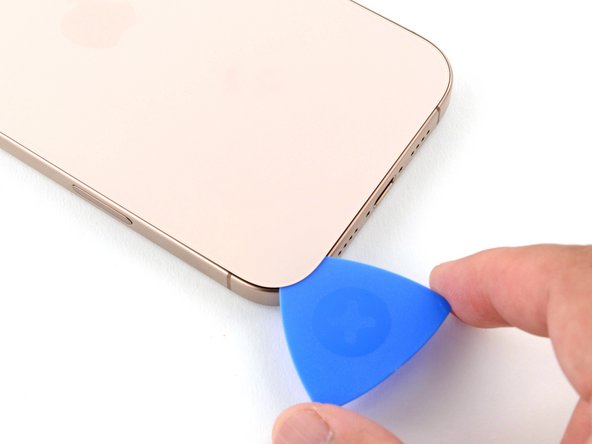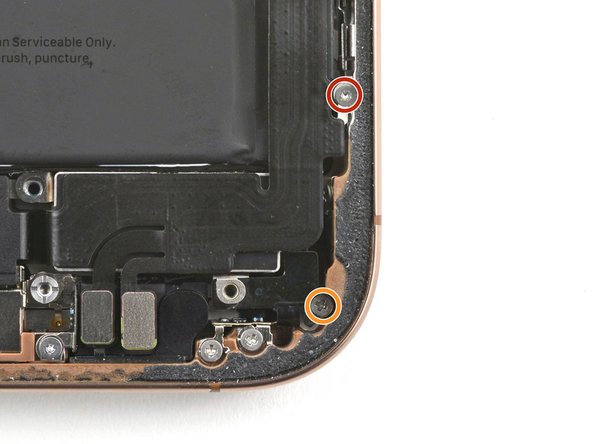How to Replace iPhone 16 Pro Max Taptic Engine Tutorial
Duration: 45 minutes
Steps: 37 Steps
Dive into this guide to remove and replace the Taptic Engine in your iPhone 16 Pro Max. Experiencing weak or no vibrations? It might be time to swap out the Taptic Engine. Don’t forget, you’ll need replacement back glass adhesive to wrap up this repair. If you need help, you can always schedule a repair.
Step 1
Let your iPhone’s battery dip below 25%—a fully charged lithium-ion battery can be a bit of a drama queen when it comes to safety.
– First things first, let’s disconnect those cables from your iPhone. It’s time for a little break!
– Now, press and hold the power button along with either of the volume buttons, then slide to power off your iPhone. You got this!
Step 2
Ensure there’s a nice, flat spot near the bottom edge that’s ample enough for a suction cup to grab onto.
– If your screen or back glass is looking a bit worse for wear with some serious cracks, don’t sweat it! Just grab some packing tape and lay down overlapping strips over the glass. This will keep you safe and make taking things apart a breeze.
Tools Used
Step 3
– Grab your trusty P2 pentalobe driver and let’s tackle those two 7.4 mm-long screws hanging out on either side of the charging port. You’ve got this!
Step 4
Be careful not to poke your device too hard with that opening pick! It’s a good idea to mark it to keep everything safe and sound.
Feel free to add some marks on the other corners of the pick with different measurements for extra precision.
Another fun trick is to tape a coin about 3 mm from the tip of your pick – it’s a handy guide!
– Grab your opening pick and measure about 3 mm from the tip. Give it a little mark with a permanent marker so you know where to go. You’ve got this!
Step 5
Get ready for a smooth opening experience with the Anti-Clamp! This handy tool is designed to make your life easier during the first four steps. If you’re going for a different approach, just hop down four steps for an alternate method.
The Anti-Clamp works its magic by applying suction to both the screen and the back glass. If you’re only looking to access the back glass, be sure to tape down the screen. For a detailed rundown on how to use this tape, be sure to check it out!
Looking for the complete scoop on using the Anti-Clamp? Dive into this guide for all the details.
Just a quick reminder: make sure the tape is only securing the screen and leaving the back glass free to open!
– Cut two strips of tape, place them along the long edges of your iPhone, and fold them over the screen to keep it snug and secure. If you need help, you can always schedule a repair
Step 6
If your iPhone’s surface feels a bit too slick for the Anti-Clamp to grip, just grab some tape and give it a little texture. It’ll hold on much better!
– Give the Anti-Clamp’s blue handle a little tug back to free those arms.
– With the back glass facing up, gently slide the arms over the right edge of your iPhone. Place one suction cup on the back glass and the other on the screen, ensuring they’re cozy near the bottom edge.
– Support your iPhone so it sits nice and level between the Anti-Clamp’s arms—using a small box works like a charm!
– Squeeze those cups together to create a solid suction. You’ve got this!
Step 7
If you’re out of tape, giving those suction cups a little warmth can help them cling better.
– Pull the blue handle forward to lock the arms in place.
– Give the handle a full 360-degree turn or until the cups start to stretch.
– As the cups stretch, keep them vertically aligned. If they slip, remove the Anti-Clamp and use tape to secure them. If you need help, you can always schedule a repair.
Step 8
Keep your cool, buddy! Don’t heat the iPhone too much—the battery is sensitive to heat. If you need help, you can always schedule a repair.
If there’s still no gap after a minute, don’t sweat it! Just add a little more heat and give the handle a quarter turn. Let the Anti‑Clamp and some patience work their magic for you.
– Grab a hair dryer or heat gun and warm up the bottom edge of the back glass until it’s nice and toasty.
– Give it about a minute for the adhesive to loosen up and a gap to form between the back glass and the frame.
– Slide an opening pick into the gap.
– Remove the Anti-Clamp by pulling on the tabs attached to the suction cups.
– Skip the next two steps.
Tools Used
Step 9
Next up, let’s create a little gap using a suction handle. It’s easier than it sounds, promise!
You can also warm up the back glass with an iOpener. Just follow these steps to get it heated and ready to go. If you need help, you can always schedule a repair.
– Grab your trusty hair dryer or heat gun and warm up the bottom edge of that back glass until it’s nice and toasty!
Tools Used
Step 10
If you don’t see a gap, give it a bit more heat and give it another shot!
– Grab a suction handle and stick it to the lower edge of that back glass.
– Give it a solid tug with steady pressure to make a little space between the back glass and the frame.
– Slide the tip of an opening pick into that newly created gap.
Tools Used
Step 11
As you carefully slice through the adhesive holding that back glass in place, remember to keep your pick no deeper than 3 mm. We want to avoid any accidental run-ins with delicate areas below!
– Watch out for that thin cable connecting the back glass to the iPhone, hanging out right next to the volume up button. Let’s keep your pick away from it to prevent any accidental slicing!
– There are multiple spring contacts around the edge of the iPhone, just waiting to be handled with care.
Step 12
If the adhesive is putting up a fight, give it a little heat for a minute and then give it another go.
– Gently glide the opening pick along the bottom edge to separate the adhesive like a pro.
– Keep that opening pick snugly in the bottom-left corner to stop the adhesive from getting back together. You’ve got this!
Step 13
– Grab a hair dryer or heat gun and warm up the left edge of that back glass until it feels nice and toasty!
Tools Used
Step 14
Keep your pick no deeper than 3 mm to steer clear of any damage to those spring contacts!
As you glide along, you’ll notice and feel the metal clips pop free. It’s like a little victory dance for your device!
– Pop in a second opening pick into the bottom-left corner, right next to your first pick. You’re building a little team here!
– Gently slide your pick along the left edge to break that stubborn adhesive and free those metal clips. You’re making progress!
– Keep that pick in the top-left corner to stop the adhesive from getting clingy again. You’re almost there!
Step 15
– Grab your trusty hair dryer or heat gun and give some love to the top edge and top-right corner of that back glass. Heat it up until it feels nice and toasty to the touch!
Tools Used
Step 16
Keep your pick to a maximum depth of 3 mm to steer clear of any accidental spring contact damage. You’ve got this!
– Pop a third opening pick into the top-left corner like a pro!
– Gently glide that pick along the top edge and around the top-right corner, making sure to pause right above the volume up button.
– Keep this pick in place to make sure the adhesive doesn’t go rogue and reseal.
Step 17
– Grab your trusty hair dryer or heat gun and gently heat up the right edge of the back glass until it’s nice and warm to the touch.
Tools Used
Step 18
Keep that pick shallow—no deeper than 3 mm—to avoid messing up the spring contacts. If you need help, you can always schedule a repair.
– Pop in a fourth opening pick at the bottom-right corner.
– Glide the pick around the corner and up the right side, stopping just under the volume down button.
– Leave the pick there to keep the adhesive from sticking again.
Step 19
By now, the back glass should be detached from the frame. If it’s still clinging on, take your pick and glide around the edges again to catch any leftover adhesive or stuck clips. If you need help, you can always schedule a repair.
– Gently swing the back glass over to the right side of your iPhone to break free from the stubborn adhesive that’s been holding it tight.
– Place a clean, sturdy object to support the back glass while you work your magic.
Step 20
– Grab your trusty tri-point Y000 driver and let’s tackle those three screws holding down the battery connector cover:
– Two screws measuring 1.3 mm in length
– One screw that’s 1.0 mm long
Step 21
– Gently pop off the battery connector cover and set it aside. You’re doing great!
Step 22
– Grab a spudger and gently pop up and disconnect the battery press connector.
– To re-attach, align the press connectors carefully and press down on one side until it clicks, then do the same on the other side.
Tools Used
Step 23
– Grab your trusty tri-point Y000 driver and let’s tackle those four screws holding the back glass connector cover in place:
– You’ll need two screws that are 1.3 mm long.
– And don’t forget the two that are 1.0 mm long.
Step 24
– Gently pop the back glass connector cover straight up and give it a little lift to detach it.
Step 25
– Grab your trusty spudger and gently wiggle it to pop up the back glass connector. Disconnecting it is a breeze!
Tools Used
Step 26
Now’s the perfect time to test your work before sealing up your iPhone. Temporarily reconnect the battery and back glass, fire it up, and make sure everything’s working smoothly. Then, power it down and finish up the reassembly.
– Gently pry off the back glass.
– As you put things back together:
– Follow this guide to reapply adhesive and snugly fit your back glass back on.
Step 27
– Grab your Phillips screwdriver and unscrew the three screws holding the Taptic Engine cover in place:
– A 2.9 mm‑long screw
– A 1.3 mm‑long screw
– A 2.4 mm‑long screw
Step 28
– Grab your tweezers or just use your fingers to gently lift the top edge of the Taptic Engine cover.
– Once you’ve unlatched the bottom edge from the frame, go ahead and take off the Taptic Engine cover.
– When putting it all back together, make sure the bottom edge of the cover latches securely to the frame.
Tools Used
Step 29
– Grab your spudger and gently pop off the lower assembly cable from the logic board. If you need help, you can always schedule a repair.
Tools Used
Step 30
– Grab your trusty spudger and gently nudge up those two connectors chilling near the bottom right corner of the frame. You’ve got this!
Tools Used
Step 31
– Time to get those lower assembly cables free! Start by taking out these two screws:
– One fabulous 1.0 mm-long tri-point Y000 screw
– One nifty 1.3 mm-long Phillips screw
Step 32
– Grab your trusty hair dryer and give some love to the lower assembly cable section right above the Taptic Engine. Warm it up until it’s nice and toasty to the touch!
Tools Used
Step 33
– Gently slide an opening pick beneath the lower assembly cable to free it from the Taptic Engine. You’ve got this!
– Carefully nudge the cable aside so you’ve got a clear path to the Taptic Engine. Easy peasy!
Step 34
– Grab your trusty Phillips screwdriver and unscrew the 2.1 mm-long screw that’s keeping that Taptic Engine snug as a bug!
Step 35
– Take the pointy end of your trusty spudger and gently nudge that corner bracket up like you’re lifting the lid on a surprise gift!
Tools Used
Step 36
– Gently glide the tip of an opening pick along the top edge of the Taptic Engine to lift the plastic buffer strip off. If you need help, you can always schedule a repair.
Step 37
Watch out! Don’t go prying on the battery; it’s a delicate dance, not a wrestling match.
– Grab your trusty spudger and carefully pry up the Taptic Engine.
– Gently lift and remove the Taptic Engine. If you need help, you can always schedule a repair
Tools Used












